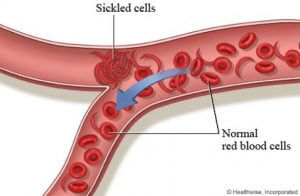Are you aware that over 100,000 individuals are living with Sickle Cell disease?
Sickle cell disease (SCD)is a genetic disease which causes some of the red blood cells (RBC) to be concave or banana shaped instead of round to properly carry oxygen. This disease is commonly found in black or African American individuals. This disease may lead to other health problems or co-morbidities that greatly affect the life of a growing child. Living with SCD as an adolescent can greatly affect them physically, academically and psychosocially.

Physical Challenges
Sickle Cell Disease (SCD) can cause vaso-occlusion or poor blood circulation of the vessels within the individual’s body. If there is poor circulation then that results in poor oxygen distribution which my lead to extreme pain and discomfort. SCD teens are often hospitalized in times of sickle cell crisis, when vaso-occlussion occurs. This can often cause them to be behind academically. They are also greatly susceptible to strokes or cerebral vascular accidents (CVA). Unfortunately controlling the symptoms of this disease may pose a bit of difficulty as many factors may trigger pain and discomfort.
Triggers/Influential factors
Stress, anxiety, environment, sleep disturbances and infection are some of the common factors that may bring on pain symptoms that accompany this disease. In this time of growth and development who doesn’t know a teenager who is encountering some sort of stress or anxiety. Whether it may be from making new friends, knowing what to wear, school work and understanding their body, all of these factors may pose or trigger stress in some way. Environmental issues such as extreme weather can also trigger a sickle cell crisis which is extremely painful on the individual. Lastly, colds and flu’s are common amongst us all but especially individuals who are in the school setting. SCD teens have to ensure that they keep a handle on other acquired illnesses to prevent periods of worsening of their symptoms.
Psychosocial Challenges
Living with SCD can have a great impact on the psychosocial aspect of a teen’s life. At this point in life teenagers are trying to gain their independents and coming into their own. Many regular teens often join the foot ball or cheer leading team and get involved into extracurricular activities that may interest them. With SCD, affected adolescents have to take into consideration the many limitations that they may have which is not pleasing to them. Children and adolescents living with SCD may be at increased risk for depression and anxiety. Those many hospital visits may cause a great number of absents from school. This may cause distance of their friendships with their peers. Not being able to perform in certain activities that their peers may be into can also heavily affect them. The increase need for or protection by their parents may cause teens to feel as though they have no independence. Continuous episodes of pain and discomfort can also contribute to heightening their anxiety.
Tips
- Allow/encourage affected teens to express themselves about their disease.
- Do not baby them (they have an illness they are not their illness)
- Encourage them to get involved in activities that are appealing yet suitable for their disease
- Determine their level of responsibility over their illness and trust that they can be responsible
- Encourage them to be a “normal” as possible.
Conclusion
It is essential that we educate ourselves on the ways in which sickle cell disease affect adolescents and to better communicate with them and help them to cope with their symptoms. Having any chronic or long term disease is never easy on any patient or individuals. Empathy, compassion and respect are necessary in caring for and contributing to the lives of these patients so they will in turn have a better quality of life. Remember these individuals have sickle cell anemia however this does not define them.
References
Abel, R. A., Cho, E., Chadwick-Mansker, K. R., D’Souza, N., Housten, A. J., & King, A. A. (2015). Transition Needs of Adolescents With Sickle Cell Disease. American Journal Of Occupational Therapy, 69(2), 1-5. doi:10.5014/ajot.2015.013730
Graves, J. K. (2016). Continuing Nursing Education. Depression, Anxiety, and Quality of Life In Children and Adolescents With Sickle Cell Disease. Pediatric Nursing, 42(3), 113-144.
Musumadi, L., Westerdale, N., & Appleby, H. (2012). An overview of the effects of sickle cell disease in adolescents. Nursing Standard, 26(26), 35-40.
